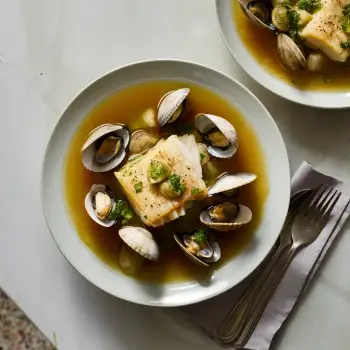
 20 minutes
20 minutesDelicate yet flavorful, this steamed halibut recipe pairs the mild, flaky fish with a spicy, tangy gochujang mayo for a harmonious blend of textures and tastes. It's a simple dish with a gourmet feel, perfect for a weeknight dinner or a special occasion.


Halibut Fillets, seasoned
0 oz
tablespoons
teaspoons
teaspoons
Lime Juice, freshly squeezed
teaspoons
1. Season the Fish
Pat the halibut fillets dry with paper towels and season both sides with salt. Let them sit for 10 minutes to allow the seasoning to penetrate. Fill the bottom of your steamer with water and bring it to a boil over high heat. Ensure the water level is low enough to not touch the fish once it's placed in the steamer basket.
2. Make the Sauce
In a small bowl, combine the mayonnaise, gochujang paste, sesame oil, and lime juice. Whisk together until smooth and fully integrated. The gochujang mayo should have a balanced flavor profile of creaminess, spice, and a hint of acidity. Adjust seasoning to taste.
3. Steam the Fish
Place the seasoned halibut fillets in a single layer in the steamer basket. Cover and steam for 8-10 minutes, or until the fish just flakes under pressure. The exact time will depend on the thickness of your fillets. Observe the fish: it should appear opaque and tender when done.
4. Serve
Carefully remove the halibut fillets from the steamer and place them onto serving plates. Dollop or drizzle the gochujang mayo over the fish.
Freshness is paramount. Look for halibut with a clean, ocean scent, firm flesh, and a glistening appearance. Avoid fish with any discoloration or a fishy smell. If possible, opt for wild-caught over farmed.
Halibut can become dry if overcooked. Aim for an internal temperature of around 135°F (57°C); the carryover cooking will bring it up to the perfect doneness as it rests.
Gochujang varies widely in flavor and heat among brands. Choose a high-quality, authentic Korean gochujang for the best flavor. Taste it beforehand and adjust the amount you use according to your heat preference.
When making the gochujang mayo, balance is key. The richness of the mayo should complement the heat of the gochujang without overpowering the delicate flavor of the halibut. Add a squeeze of lemon juice or a teaspoon of rice vinegar to the mayo for a bright note that cuts through the richness.
Allow the fish to rest for a few minutes after steaming. This helps the juices redistribute and results in a more succulent texture.




Comments (0)